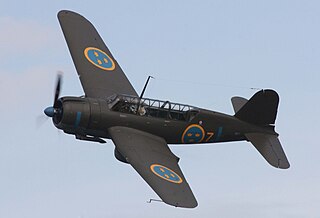
The Saab 17 is a Swedish single-engine monoplane reconnaissance dive-bomber aircraft of the 1940s originally developed by ASJA prior to its merger into Saab. It was the first all-metal stressed skin aircraft developed in Sweden.

Svenska Aero Jaktfalken was a Swedish biplane fighter aircraft, constructed in the late 1920s. The aircraft was first manufactured by Svenska Aero from 1929 to 1932 and later by AB Svenska Järnvägsverkstädernas Aeroplanavdelning (ASJA) from 1934 to 1935.

The Valmet Tuuli was a trainer aircraft, developed for the Finnish Air Force by the State Aircraft Factory. The aircraft was to be produced in 3 different versions. The last version, Tuuli III was redesigned from scratch, and is basically an entirely different aircraft.

Adaridi AD 3 was a wooden aircraft designed by the Russian engineer Boris Adaridin, who lived in Finland. It was a high wing aircraft with a low-powered engine. In 1923, the Finnish Air Force ordered one Adaridi aircraft. The aircraft was not given any official designation code. The maiden flight was on April 17, 1924.

Fokker D.X was a Dutch fighter aircraft designed after World War I.

Friedrichshafen FF.33 was a German single-engined reconnaissance three-bay wing structure biplane, using twin floats, designed by Flugzeugbau Friedrichshafen in 1914 for the Marine-Fliegerabteilung aviation forces of the Kaiserliche Marine.

The Friedrichshafen FF.41a was a large, German-built, three-seat, twin-engine floatplane reconnaissance aircraft designed by Flugzeugbau Friedrichshafen in 1917.

Friedrichshafen FF.49 was a German, two-seat, single-engine float-plane designed by Flugzeugbau Friedrichshafen in 1917.

Georges Levy G.L. 40 HB2 was a three-seated French, amphibious biplane aircraft that was designed in 1917. The aircraft was designed by Blanchard and Le Pen and therefore the aircraft was also known as the Levy-Le Pen. Le Pen was Maurice Jules-Marie Le Pen born in Lorient, Morbihan, France in 1889; he was killed in a car crash in 1919. It was claimed to be the best French amphibious aircraft of World War I, but that is probably due to the low scale production of such aircraft in France at that time.

IVL K.1 Kurki was a prototype for a four-seated, high-wing trainer aircraft, which was designed in 1927 by IVL. The designer was Asser Järvinen and the prototype was manufactured at the IVL plant at Suomenlinna. The aircraft made its maiden flight on March 30, 1927. Only one aircraft was manufactured.

Junkers A 35 was a two-seater cantilever monoplane, used for postal, training and military purposes. The aircraft was designed in the 1920s by Junkers in Germany and manufactured at Dessau and by AB Flygindustri in Limhamn, Sweden and conversions from A 20s were made in Fili, Russia.

The LVG C.VI was a German two-seat reconnaissance and artillery spotting aircraft used during World War I.

Grigorovich M-5 was a successful Russian World War I-era two-bay unequal-span biplane flying boat with a single step hull, designed by Grigorovich. It was the first mass production flying boat built in Russia.

The Grigorovich M-9 was a Russian World War I-era biplane flying boat, developed from the M-5 by Grigorovich.

Grigorovich M-15 was a successful Russian World War I-era biplane flying boat, developed from the M-9 by Grigorovich.
Grigorovich M-16 was a successful Russian World War I-era biplane flying boat of the Farman type, developed from the M-9 by Grigorovich. Somewhat larger than the M-9, the M-16 was a version especially intended for winter operations, with better aerodynamic qualities.

Morane-Saulnier MoS-50 was a French parasol configuration trainer aircraft built in 1924. The twin-seat aircraft was of wooden construction and was one of the last aircraft to have a rotary engine, a 97 kW (130 hp) Clerget 9B.

The Klemm Kl 35 is a German sporting and training aeroplane developed as a successor to the Kl 25. A product of Klemm Leichtflugzeugbau Gmbh it shared the same single-engine, cantilever low-wing configuration as the earlier machine, the major difference being the introduction of an inverted gull wing.
Raab-Katzenstein was a 1920s German aircraft manufacturer based in Kassel.

The Raab-Katzenstein KL.1 Schwalbe (Swallow) was a German two-seat biplane produced in the 1920s. About fifty were built and the type became well known as an aerobatic aircraft, performing at many displays in the hands of pilots like Gerhard Fieseler.


















